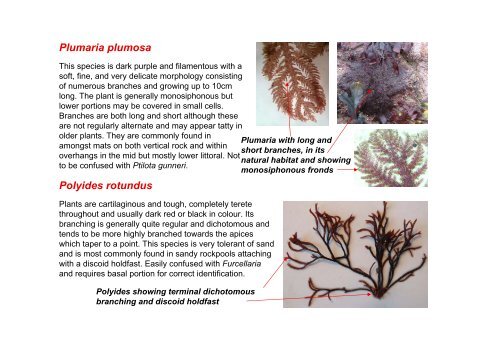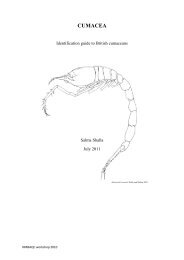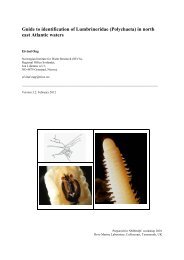s A Field Guide to the British Seaweeds - NMBAQC
s A Field Guide to the British Seaweeds - NMBAQC
s A Field Guide to the British Seaweeds - NMBAQC
Create successful ePaper yourself
Turn your PDF publications into a flip-book with our unique Google optimized e-Paper software.
Plumaria plumosa<br />
This species is dark purple and filamen<strong>to</strong>us with a<br />
soft, fine, and very delicate morphology consisting<br />
of numerous branches and growing up <strong>to</strong> 10cm<br />
long. The plant is generally monosiphonous but<br />
lower portions may be covered in small cells.<br />
Branches are both long and short although <strong>the</strong>se<br />
are not regularly alternate and may appear tatty in<br />
older plants. They are commonly found in<br />
amongst mats on both vertical rock and within<br />
overhangs in <strong>the</strong> mid but mostly lower lit<strong>to</strong>ral. Not<br />
<strong>to</strong> be confused with Ptilota gunneri.<br />
Polyides rotundus<br />
Plants are cartilaginous and <strong>to</strong>ugh, completely terete<br />
throughout and usually dark red or black in colour. Its<br />
branching is generally quite regular and dicho<strong>to</strong>mous and<br />
tends <strong>to</strong> be more highly branched <strong>to</strong>wards <strong>the</strong> apices<br />
which taper <strong>to</strong> a point. This species is very <strong>to</strong>lerant of sand<br />
and is most commonly found in sandy rockpools attaching<br />
with a discoid holdfast. Easily confused with Furcellaria<br />
and requires basal portion for correct identification.<br />
Polyides showing terminal dicho<strong>to</strong>mous<br />
branching and discoid holdfast<br />
Plumaria with long and<br />
short branches, in its<br />
natural habitat and showing<br />
monosiphonous fronds




